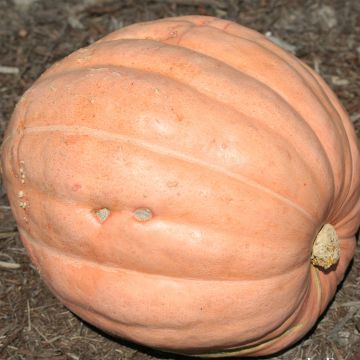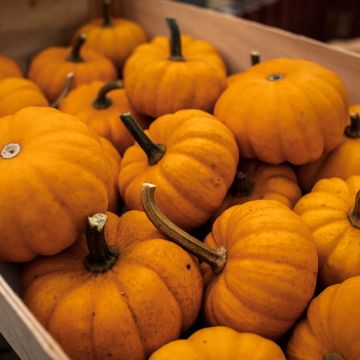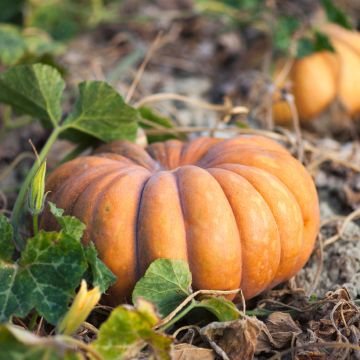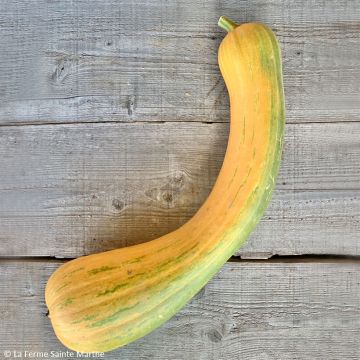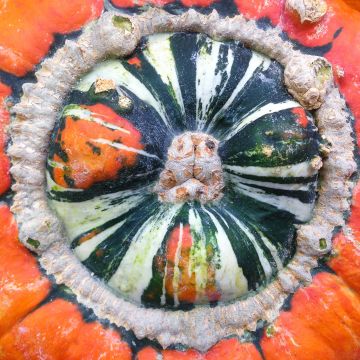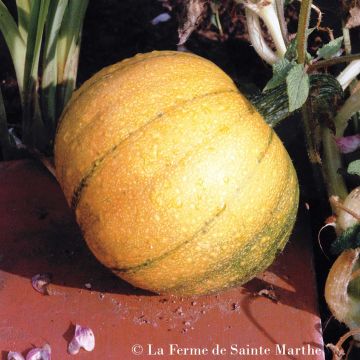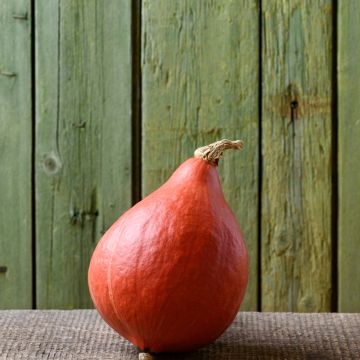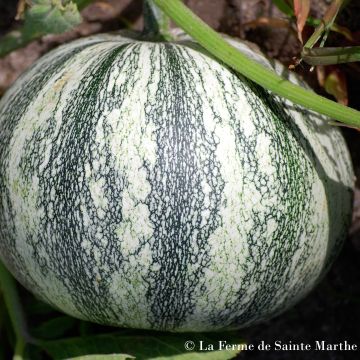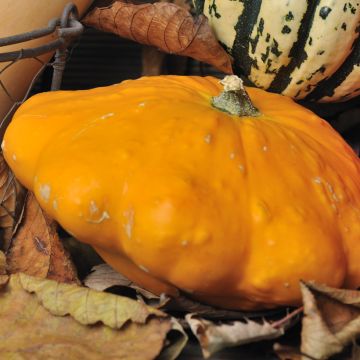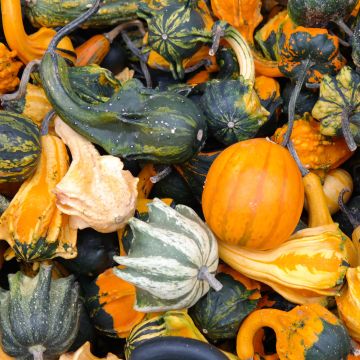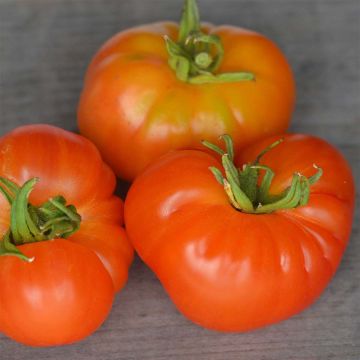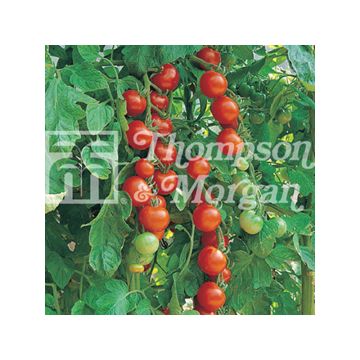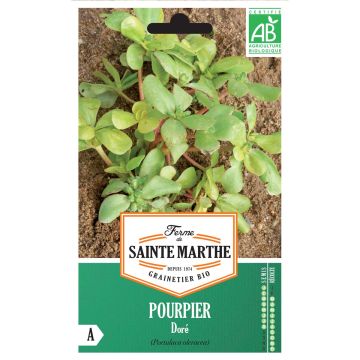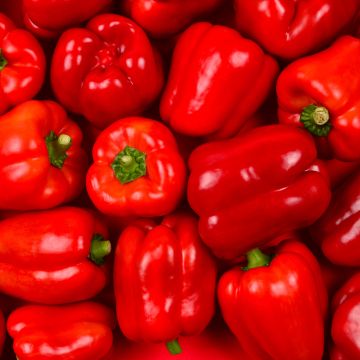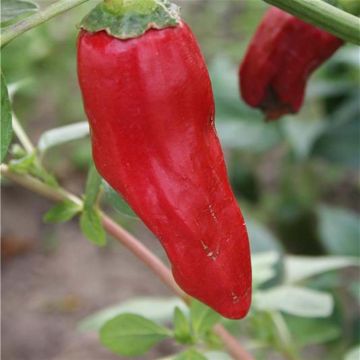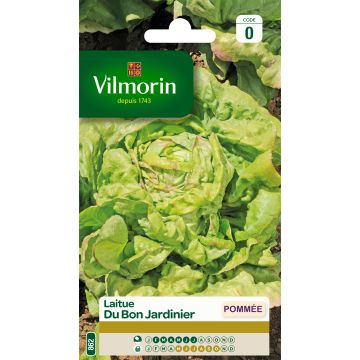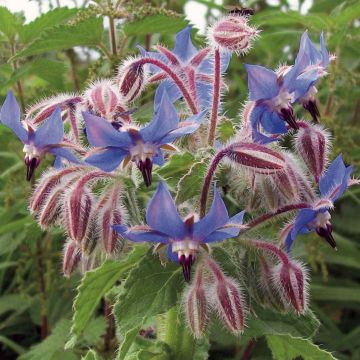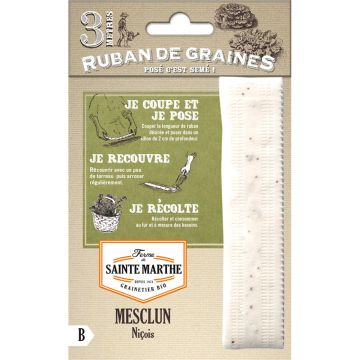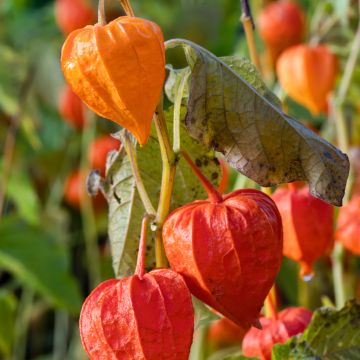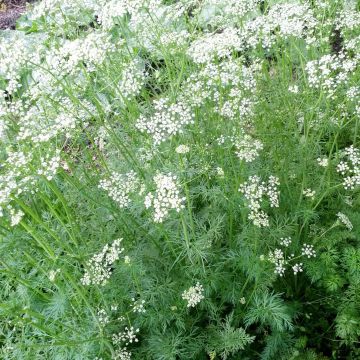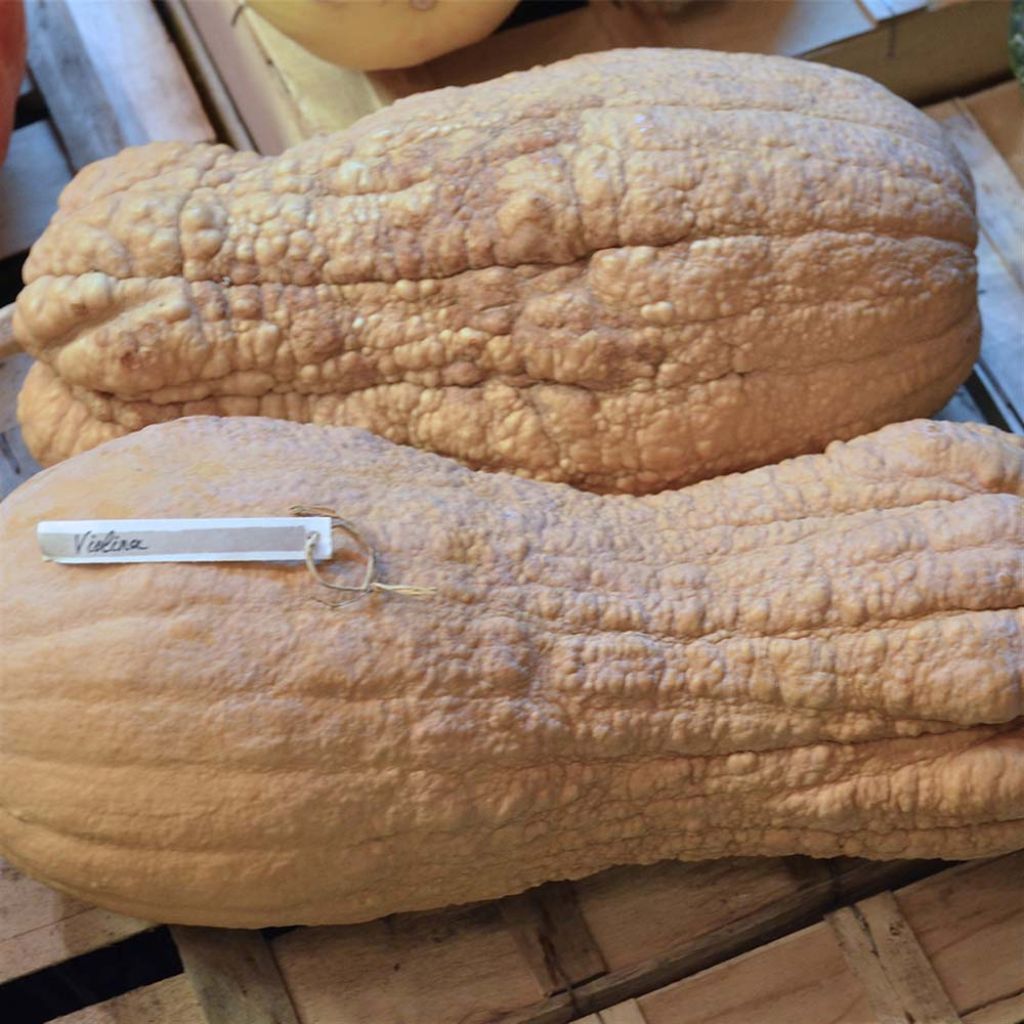

Courge musquée Violina bio - Ferme de Sainte Marthe


Courge musquée Violina bio - Ferme de Sainte Marthe
Cucurbita moschata Violina - Organic
Cucurbita moschata musquée Violina bio
Butternut squash 'Violina', Crookneck squash 'Violina'
This item cannot be shipped to the selected country
Dispatch by letter from €3.90
More information
Schedule delivery date,
and select date in basket
This plant carries a 6 months recovery warranty
More information
We guarantee the quality of our plants for a full growing cycle, and will replace at our expense any plant that fails to recover under normal climatic and planting conditions.
Seed-only orders are dispatched by sealed envelope. The delivery charge for seed-only orders is €3.90.
Description
Cucurbita moschata 'Violina' is an old French variety of butternut squash. Its fruits, measuring 60cm (24in) to 1m (3ft) in length and 10 to 18cm (4 to 7in) in diameter, weigh between 3 and 10kg. It produces 2 to 4 fruits per plant. It can be consumed when young as a courgette or when ripe, in which case it should be harvested in mid-October. Its light orange flesh is musky and firm. Sow the seeds from April to June. Harvest from September to October.
Orange, green, red, yellow, black or even blue, smooth, ribbed, warty, with tender skin, etc. squashes and courgettes boast an astonishing variability of shapes, colours, sizes. They hybridise with remarkable ease, hence the huge number of varieties.
In common language, winter squash refers to all kinds of pumpkins, potimarrons, pumpkins, etc. with tough skin and delicately sweet flesh. By summer squash or courgettes, we mean the different varieties that are harvested when the skin is still tender and young. These are consumed with the seeds.
They are all native to America and belong to the large Cucurbitaceae family. They were introduced to Europe in the 16th century. Generally trailing, they cling to any support with their tendrils. Female flowers are distinguished from male flowers by their inferior ovary (under the flower), resembling an embryo of fruit. In many regions, male flowers are harvested after pollination to be eaten stuffed or in fritters. There are many ways to consume squashes and courgettes. They can be sautéed, fried, baked, made into soups or stuffed. Courgettes are a key ingredient in Provençal ratatouille, Italian caponata, North African couscous, and many other emblematic Mediterranean dishes. Courgettes and squashes are low in calories but rich in vitamins, especially provitamin A, vitamin B, and minerals.
Harvesting: squashes should be harvested when fully ripe, unless there is a risk of rotting. In that case, they can finish ripening indoors. Courgettes are harvested young and fresh, while still immature. Both should be handled with care and remain free from any cuts or bruises.
Storage: courgettes can be cut into pieces and frozen. Their fragile skin is not suitable for preservation as it is. Winter squashes with tough skin can be stored for several months and consumed throughout winter. Unlike other fruits and vegetables, they need warmth for optimal storage. There is no need to store them in a dark place, so it's best to store them where their plump silhouette can be appreciated.
Gardener's tip: place a slate or tile under the fruit. It will no longer be in direct contact with the ground, thus avoiding rotting due to moisture. They also particularly like slightly moist soils. Mulch around the plants, especially during the height of summer. Squashes and courgettes are very susceptible to powdery mildew (a fungal disease that leaves a white fuzz on the surface of the leaves). Avoid watering the leaves or flowers. Plant your squashes with alliums like chives, onions or shallots, or with legumes like beans or peas. However, the marriage of squash and cucumber may be detrimental to both parties.
Organic or "AB" seeds come from plants grown using organic farming methods (without the use of pesticides). They undergo no treatment after harvest. These seeds are suitable for organic market gardening.
Report an error about the product description
Harvest
Plant habit
Foliage
Botanical data
Cucurbita
moschata
musquée Violina bio
Cucurbitaceae
Butternut squash 'Violina', Crookneck squash 'Violina'
Mediterranean
Annual
Other Squash, Courgette and Pumpkin seeds
Planting and care
Growing squash and courgettes is very rewarding, both for the quick growth of the plants and for the ease of cultivation. They need well-drained soil rich in organic matter. For beautiful fruits, they also require plenty of sunlight and water.
Early cultivation
In March and April, sow your seeds in groups of two or three in trays or pots with soil rich in organic matter. Lightly cover the seeds and then water to maintain a slight level of moisture. Germination is quite fast. After about ten days, thin out by selecting the strongest seedlings, then transplant them into the prepared soil. Each plant requires a lot of space. If possible, space them 1m (3ft) apart. Dig holes 20 to 25cm (8 to 10in) in all directions and fill them two-thirds full with compost. Place the plant in the hole and backfill with soil, then compact firmly.
Seasonal cultivation
Once the risk of frost has passed, typically in late April or May depending on the region, sow two to three seeds per hole at a depth of 2 to 3cm (1in). Lightly tamp down the soil and wait for about ten days for the first shoots to appear. When they have reached a few centimetres in height, thin out and keep only the strongest plants.
Harvesting can begin in July for immaturely picked courgettes. Squash is harvested in autumn. A simple method to determine the optimal time for harvesting is to observe the stem. If it is completely dry and the fruit is ready to detach itself, then it is time to harvest.
Seedlings
Care
Intended location
This item has not been reviewed yet - be the first to leave a review about it.
Vegetable seeds
Haven't found what you were looking for?
Hardiness is the lowest winter temperature a plant can endure without suffering serious damage or even dying. However, hardiness is affected by location (a sheltered area, such as a patio), protection (winter cover) and soil type (hardiness is improved by well-drained soil).

Photo Sharing Terms & Conditions
In order to encourage gardeners to interact and share their experiences, Promesse de fleurs offers various media enabling content to be uploaded onto its Site - in particular via the ‘Photo sharing’ module.
The User agrees to refrain from:
- Posting any content that is illegal, prejudicial, insulting, racist, inciteful to hatred, revisionist, contrary to public decency, that infringes on privacy or on the privacy rights of third parties, in particular the publicity rights of persons and goods, intellectual property rights, or the right to privacy.
- Submitting content on behalf of a third party;
- Impersonate the identity of a third party and/or publish any personal information about a third party;
In general, the User undertakes to refrain from any unethical behaviour.
All Content (in particular text, comments, files, images, photos, videos, creative works, etc.), which may be subject to property or intellectual property rights, image or other private rights, shall remain the property of the User, subject to the limited rights granted by the terms of the licence granted by Promesse de fleurs as stated below. Users are at liberty to publish or not to publish such Content on the Site, notably via the ‘Photo Sharing’ facility, and accept that this Content shall be made public and freely accessible, notably on the Internet.
Users further acknowledge, undertake to have ,and guarantee that they hold all necessary rights and permissions to publish such material on the Site, in particular with regard to the legislation in force pertaining to any privacy, property, intellectual property, image, or contractual rights, or rights of any other nature. By publishing such Content on the Site, Users acknowledge accepting full liability as publishers of the Content within the meaning of the law, and grant Promesse de fleurs, free of charge, an inclusive, worldwide licence for the said Content for the entire duration of its publication, including all reproduction, representation, up/downloading, displaying, performing, transmission, and storage rights.
Users also grant permission for their name to be linked to the Content and accept that this link may not always be made available.
By engaging in posting material, Users consent to their Content becoming automatically accessible on the Internet, in particular on other sites and/or blogs and/or web pages of the Promesse de fleurs site, including in particular social pages and the Promesse de fleurs catalogue.
Users may secure the removal of entrusted content free of charge by issuing a simple request via our contact form.
The flowering period indicated on our website applies to countries and regions located in USDA zone 8 (France, the United Kingdom, Ireland, the Netherlands, etc.)
It will vary according to where you live:
- In zones 9 to 10 (Italy, Spain, Greece, etc.), flowering will occur about 2 to 4 weeks earlier.
- In zones 6 to 7 (Germany, Poland, Slovenia, and lower mountainous regions), flowering will be delayed by 2 to 3 weeks.
- In zone 5 (Central Europe, Scandinavia), blooming will be delayed by 3 to 5 weeks.
In temperate climates, pruning of spring-flowering shrubs (forsythia, spireas, etc.) should be done just after flowering.
Pruning of summer-flowering shrubs (Indian Lilac, Perovskia, etc.) can be done in winter or spring.
In cold regions as well as with frost-sensitive plants, avoid pruning too early when severe frosts may still occur.
The planting period indicated on our website applies to countries and regions located in USDA zone 8 (France, United Kingdom, Ireland, Netherlands).
It will vary according to where you live:
- In Mediterranean zones (Marseille, Madrid, Milan, etc.), autumn and winter are the best planting periods.
- In continental zones (Strasbourg, Munich, Vienna, etc.), delay planting by 2 to 3 weeks in spring and bring it forward by 2 to 4 weeks in autumn.
- In mountainous regions (the Alps, Pyrenees, Carpathians, etc.), it is best to plant in late spring (May-June) or late summer (August-September).
The harvesting period indicated on our website applies to countries and regions in USDA zone 8 (France, England, Ireland, the Netherlands).
In colder areas (Scandinavia, Poland, Austria...) fruit and vegetable harvests are likely to be delayed by 3-4 weeks.
In warmer areas (Italy, Spain, Greece, etc.), harvesting will probably take place earlier, depending on weather conditions.
The sowing periods indicated on our website apply to countries and regions within USDA Zone 8 (France, UK, Ireland, Netherlands).
In colder areas (Scandinavia, Poland, Austria...), delay any outdoor sowing by 3-4 weeks, or sow under glass.
In warmer climes (Italy, Spain, Greece, etc.), bring outdoor sowing forward by a few weeks.

































